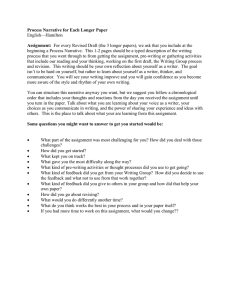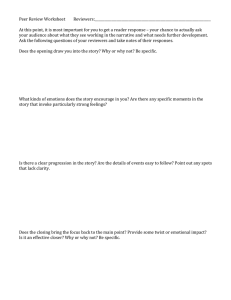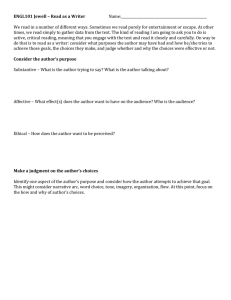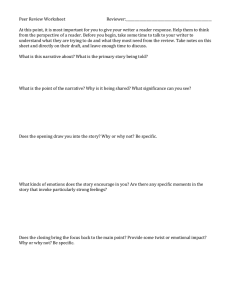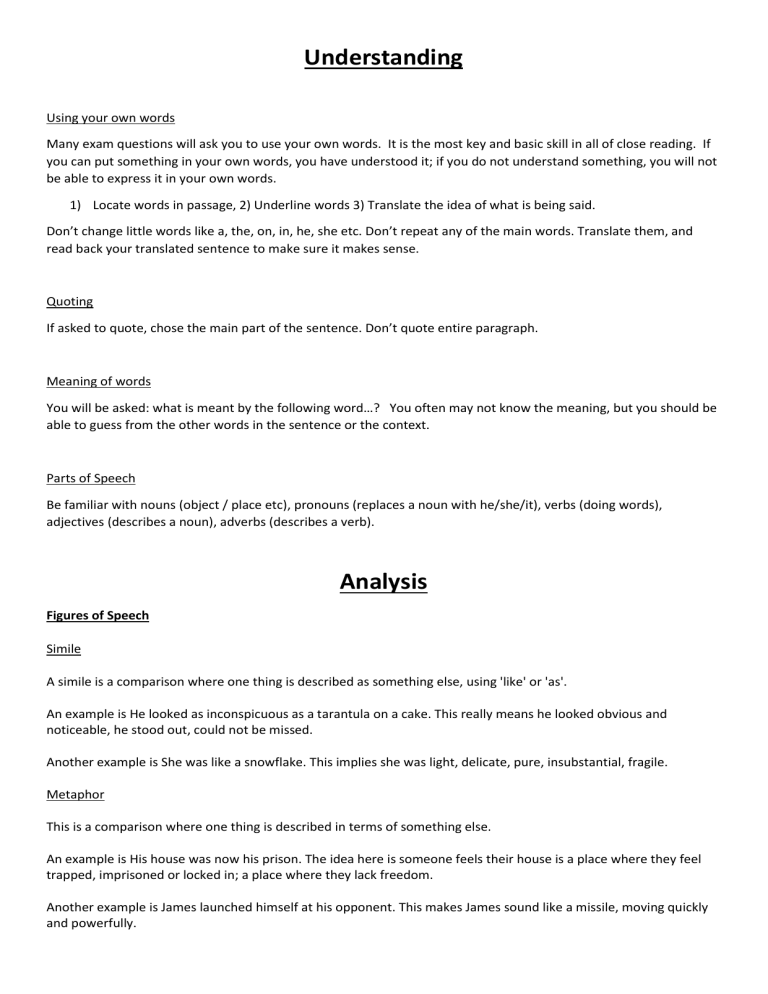
Understanding Using your own words Many exam questions will ask you to use your own words. It is the most key and basic skill in all of close reading. If you can put something in your own words, you have understood it; if you do not understand something, you will not be able to express it in your own words. 1) Locate words in passage, 2) Underline words 3) Translate the idea of what is being said. Don’t change little words like a, the, on, in, he, she etc. Don’t repeat any of the main words. Translate them, and read back your translated sentence to make sure it makes sense. Quoting If asked to quote, chose the main part of the sentence. Don’t quote entire paragraph. Meaning of words You will be asked: what is meant by the following word…? You often may not know the meaning, but you should be able to guess from the other words in the sentence or the context. Parts of Speech Be familiar with nouns (object / place etc), pronouns (replaces a noun with he/she/it), verbs (doing words), adjectives (describes a noun), adverbs (describes a verb). Analysis Figures of Speech Simile A simile is a comparison where one thing is described as something else, using 'like' or 'as'. An example is He looked as inconspicuous as a tarantula on a cake. This really means he looked obvious and noticeable, he stood out, could not be missed. Another example is She was like a snowflake. This implies she was light, delicate, pure, insubstantial, fragile. Metaphor This is a comparison where one thing is described in terms of something else. An example is His house was now his prison. The idea here is someone feels their house is a place where they feel trapped, imprisoned or locked in; a place where they lack freedom. Another example is James launched himself at his opponent. This makes James sound like a missile, moving quickly and powerfully. Personification This is a comparison where something non-human (inanimate) is described in human terms. An example is Death stalked the battlefield. Death is being portrayed as a figure or person hunting for someone. Alliteration This is where consecutive words begin with the same letter and, more importantly, the same sound. An example is The rifles rapid rattle. The repetition of the 'r' sound echoes the sound of machine guns being fired. Onomatopoeia This is where a word makes the sound of the thing it describes. An example is The ringmaster cracked his whip. This implies the whip making a sharp sound. Another example is Stuttering rifles rapid rattle. The stuttering imitates the action of a machine-gun being fired. Imagery This is where strong pictures or ideas are created in the mind of the reader. Similes, metaphors and personification can all be used to achieve this - they all compare something 'real' with something 'imagined'. There is a method for analysing images. You begin with what the image literally is like, or literally means. Then you go on to the metaphorical meaning, showing how that image applies to and adds meaning to the subject under discussion. Use this structure for your analysis: Just as…(explain the literal meaning), so …(explain the metaphorical meaning). Example: He has a mountain of work to do. You could analyse the image like this: Just as a mountain is large and is challenging to climb, so the amount of work he has to do is enormous and will be really difficult. Sentence Structure Structure, in this context, means how a sentence is built up or constructed. The following are some features you may notice while reading. Repetition When single words, or groups of words, are repeated for emphasis. Lists If a list is present, look at the order in which the points are listed. If they lead up to the most important item at the end, there is a build-up to a climax. Listing many items may emphasise the point. Sentence length Short sentences may be used to build up tension. Longer sentences may be used for explanation or to convey complexity. Sentence types Statements – a normal sentence. Commands – an instruction. Questions – asking for information/ rhetorical (they finish with question marks). Exclamations – used to express emotions (they finish with exclamation marks Questions and rhetorical questions might be used. An exclamation such as How amazing! can be used to indicate a strong emotional reaction. Contrast Individual words or groups of words can be placed side by side – in juxtaposition – to stress the contrast between ideas. Parenthesis Where extra information is included in the middle of a sentence, contained within dashes, brackets or commas. Ellipsis Where three dots (...) are used to indicate something more could be added. Punctuation Punctuation is often key to sentence structure. There are many possibilities for punctuation that can help you with sentence structure. A colon (:) introduces a list A single dash (-) can be used to introduce an idea, a list or an explanation. They are used to add additional information about a specific thing A semi-colon (;) separates items on a list; separates two parts of a sentence. may show contrast in the ideas before and after. Use of question marks is always worth consideration. Questions may be rhetorical, but not always. Word choice When considering the language used by a writer, you can think of another word or expression the writer could have used. This will then allow you to compare the word used against an alternative and consider what the advantage was of using the word selected for the text. Think about the connotations of the word – in other words, what do you associate it with? For example, ‘slender’, ‘slim’, ‘thin’, ‘lean’ and ‘skinny’ may all have similar meanings but their connotations can be either negative or positive. If asked to comment on the writer's use of one of these words, thinking about the connotations will help you come up with a suitable comment. Another approach is to consider if the words used are informal or formal. A popular technique is to use a mixture of the two. You should also think about the effect produced by the sound of words, through the use of techniques such as alliteration and onomatopoeia. Tone Tone refers to the attitude that a writer conveys towards a subject. A writer may be passionately for or against a particular topic and express this through various means. It could be that emotional language is used - this is known as an emotive tone. Humour can be applied either affectionately or mockingly. Other kinds of tone you may encounter in a piece of writing include light-hearted, ironic, sarcastic, angry, gloomy, anxious, joyful or sorrowful. Some of the most common tones that crop up in exam questions are humorous, matter –of-fact, critical, angry, conversational, formal, informal, etc. Narrative Most narratives are written in either the first or the third person. First person narrative is where the 'voice' telling the story uses the word 'I'. This can have an intimate, believable confessional feel. Third person narrative is where the author uses 'he', 'she', 'they' or 'it'. A voice refers to actions, events and circumstances dissociated from both the narrator and the reader. Second person narratives, where the author tells the story using 'you' are more unusual. In this kind of narrative the reader is addressed directly and is involved as part of the story. There is often a sense of discovery or reveal with this kind of narrative voice. The narrative point of view is, then, crucial in revealing and telling us about characters - and also in helping the story to be told in an exciting, structured and significant way. Purpose Different texts are written for different reasons – the purpose Fiction : To entertain. If you are asked to give a reason for your answer, find a quotation which talks about the character/setting/ theme and explain that you enjoyed reading about this. Non-fiction: To inform. If you are asked to give a reason for your answer, find a fact from the text and explain that it provides information
